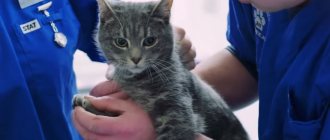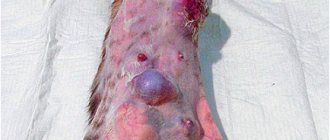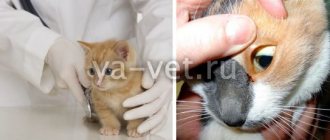The nervous system determines our very existence, thinking and behavior. Of course, our cats and other domestic animals do not make scientific discoveries or write poems, but the brain is extremely important for them too. Any pathology can lead to tragedy. A brain tumor in cats is extremely dangerous, as its appearance sometimes leads to unpredictable and extremely serious consequences.
What are they?
Neoplasms are primary and secondary. Primary, as the name suggests, arises directly in the brain. Sometimes they grow inside the brain itself, sometimes in the depths of the meninges. In turn, primary tumors are divided into malignant and benign. Secondary neoplasms are a consequence of cancerous pathologies inside other internal organs. Abnormal cells enter the brain along with metastases. It should be remembered that all tumors that arise in the optic or auditory nerves (and similar tissues) are always primary. As we have already said, neoplasms can be benign (without metastases, with clear boundaries) and malignant. The latter quickly spread throughout the body through metastases and do not have clear localization or boundaries.
What can cause swelling?
There are a huge number of different reasons and even full-fledged diseases that can cause such a problem. Here are the most common and frequently encountered ones:
- Injury. A pet that has free access to the street can easily get into a fight with its relatives. Cat fights are brutal and the claws are sharp: the animals inflict a variety of injuries on each other, and most often the head suffers. Torn eyelids, ears and lips become very swollen. The jaw may be broken and swelling develops at the site of injury. There is a high probability of developing an abscess (abscess) if an infection gets into an open wound.
- Abscess (ulcer, abscess). This is the formation of a cavity in the tissues filled with purulent fluid from decomposed blood cells and tissue fibers. An abscess can develop anywhere, and the most common cause is infection. If your cat's face is swollen in the cheek area, you should also examine the teeth and gums. Diseases of the oral cavity can be accompanied by tissue suppuration - gumboil. Only a veterinarian should open an abscess. Sometimes the cavity quickly grows to a decent size, and then surgery under general anesthesia is required. Treatment of an abscess after surgery is a long and extremely painful process for the animal, since several times a day it is necessary to move the edges of the wound apart, clean the cavity of accumulated secretions and apply a special ointment.
- Insect bite. Most often, pets suffer from hymenoptera bites: wasps, bees, bumblebees. Cats are careful and dexterous animals, but sometimes they get excited and play with dangerous insects. A swelling appears at the site of the bite. The most vulnerable parts of the muzzle are the nose, lips and eyelids. Usually the upper lip swells first, then the area near the eye. If the incident occurred in front of the owner and there is no doubt about the cause of the swelling, you need to take the cat to the veterinary clinic as soon as possible.
- Exoparasites - fleas. Flea saliva and excrement can cause an allergic reaction in your pet. Allergen exposure occurs when a cat catches and bites an insect. As the process progresses, sores appear on the face, which take a very long time to heal.
- Allergy. Another reason why a cat's face is swollen may be an allergic reaction. Anything can be a provoking factor: new food (even high-quality - holistic class), scented toilet litter, shampoo, toilet detergent. It is not recommended to give your pet antihistamines without a veterinarian's prescription. If you suspect an allergy, a visit to the veterinary clinic should not be postponed.
- Snake bites. Even if a cat sees the street only through the window most of the year, at the dacha he is able to demonstrate extraordinary hunting skills. Some cats deftly catch reptiles: lizards and snakes. But during the hunt, the animal may be inferior to the snake in the speed of reaction, and instead of a trophy it receives a bite - most often in the face. Snake venom is toxic and causes an allergic reaction in the form of swelling. If you suspect a snake bite, you should immediately take your pet to the vet.
- Acne (inflammation of the ducts of the sebaceous glands). This disease, which is usually associated with adolescence in humans, also occurs in cats. They also have sebaceous glands that are connected to the hair follicles and provide the coat with a water-repellent effect. There are places on the animal’s body with an increased number of these glands, one of them is the chin. First, inflammation of the sebaceous ducts on the chin is accompanied by the appearance of blackheads (comedones). If the animal is not treated, folliculitis develops - an inflammatory process in which voids with pus form in the follicles. In this case, the muzzle in the chin area may swell noticeably. Although acne is not fatal, it is not recommended to delay a trip to the veterinarian.
- Inflammation of the lymph nodes. Lymphadenitis is inflammation of the lymph nodes, accompanied by severe swelling of the tissue. If your cat's muzzle is swollen in the area of the jaw and upper neck, it may be due to lymphadenitis. Only a veterinarian can make an accurate diagnosis.
- Neoplasm (tumor). The growing tissue of the neoplasm looks like a swelling. Sometimes the tumor puts pressure on the lymphatic vessels, which leads to stagnation of lymph and the formation of edema. If a swelling appears on your pet’s face, you need to urgently contact a veterinary clinic, even if it is small and does not bother the animal at all. The neoplasm may be malignant, and then urgent surgery followed by special therapy will be required.
- Houseplants. Most of them are toxic to cats and can cause poisoning or swelling: after all, they taste all the greens. The list of safe ones is much shorter, the most common are cacti and orchids.
As you can see, the list of possible causes is quite large, so it is not possible to independently determine why the cat’s muzzle is swollen. To make a diagnosis, it is recommended to visit a qualified veterinarian in person.
What to do?
If you notice any of the signs described above in your pet, contact your veterinarian immediately! Even cancer today is not a death sentence, including in pets. In some cases, you can even do without major operations, since modern drugs give good results during chemotherapy. If we are talking about a neoplasm of benign etiology, then it (with a high degree of probability) can be removed surgically, after which the animal will live a long and happy life! In short, brain tumors in cats can be cured today, so in no case should you delay going to the veterinary clinic.
The main causes of bumps on a cat's head
Any tumor appears for a reason. Everything has its reasons. If a lump has jumped up on your head, it could be :
- Hematoma is one of the most common causes of bumps on a cat's head. It is a formation that occurs as a result of closed-type mechanical damage (bone fracture, rupture of blood vessels, etc.). Blood accumulates under the skin - hence the lump. Usually hematomas are painful, the skin over them first turns red, then turns blue. Small external lesions with dried blood may be visible. The head is a “favorite” place for hematomas, because it is the one that most often suffers in cat fights. As a result, furry bullies develop bumps around the eyes, ears and other areas of the skull.
- The oncological process is one of the most dangerous causes. Sometimes with cancer you can see small bumps on your cat's head. These are metastases caused by a malignant tumor of a particular organ. The tubercles are usually very small, there are many of them. They can be located not only on the head, but also on other parts of the cat’s body: paws, neck.
- Lipoma is one of the most harmless causes. People call such formations “wen.” They are also common in humans. Occur due to the proliferation of adipose tissue. These cones are soft and often large in size. They are a benign tumor that extremely rarely degenerates into malignant.
- Allergy . The appearance of a small bump on a cat’s head sometimes indicates a negative reaction to a particular stimulus. A cat can be allergic to anything: to a certain food, to dust, to tobacco smoke, etc. The bumps on it are tiny. Usually there are a lot of them. The skin above and around them becomes red and itchy.
- An abscess is a purulent inflammation in the form of a lump on the head. Very painful. May be accompanied by an increase in body temperature and a deterioration in the general condition of the body. It often results from parasite bites that the cat scratches, causing infection. Sometimes an abscess develops as a result of an unsuccessful injection, when antiseptic treatment was not properly carried out, and pathogenic bacteria entered the wound.
© shutterstock
Of course, this is not a complete list of the causes of a bump on a cat’s head. We have listed only the most common ones. It is difficult for the owner to understand which exactly provoked the appearance of the tumor. It is necessary to show the animal to a doctor.
Weight loss
Weight loss is a very clear symptom of cancer in a cat. Dr. Seidel says this sign is evidence of a gastrointestinal tumor.
“When cats are offered food during feeding hours but turn away from the bowl or refuse food, this should not go unnoticed,” he says. “Cancer can also cause a cat to lose weight but still retain her appetite. If you notice your cat is losing weight, it's time to make an appointment with your veterinarian."
Oral lesions
Ulcers, growths, bleeding gums or changes in their color can be a sign of cancer in a cat, especially in an adult. These signs in cats often go undetected for too long. “We usually detect visible oral tumors too late because people don't look at their pet's mouth,” Seidel says.
Be open to change: habits that will make your relationship with a friend stronger
An effective product in the fight against obesity: facts about the beneficial properties of guava
A girl almost broke up with her boyfriend because of a label on a mattress
"It's good to observe when your pet yawns or eats," advises Timothy Rocha, DVM, an oncology specialist in New York City.
Methods for diagnosing tumors in cats
When contacting a veterinarian with a suspicion of an oncological process, the doctor will prescribe the following examinations: laboratory tests of blood and urine, ultrasound, x-rays, MRI, computed tomography, endoscopy and histological studies. In some cases, a biopsy is performed to determine the nature of the tumor.
Treatment of oncology - tumors in cats
In cancer treatment, the location of the tumor, its type, and the stage of the disease play a role. Cancer cannot be treated with folk remedies and herbs
, you will only waste time and soon your pet. In the early stages, surgery to remove the tumor, chemotherapy, radiation and immune therapy are used. All this is decided individually by a veterinarian; it is not easy to predict the result at the beginning of therapy, since each cat will react to treatment and fight the disease in its own way. Proper treatment will completely defeat the cancer or achieve long-term remission, prolonging the full life of your pet.
In later stages of the disease
we are no longer talking about recovery, but about reducing suffering and improving the general condition of the little patient. After considering the situation, the owner may decide to euthanize the pet in order to save it from prolonged suffering and pain. Naturally, having heard a terrible diagnosis, you should not immediately give up and give up; you should listen to the doctor’s opinion. Nothing prevents you from having your animal examined in different clinics if you are in doubt about the diagnosis and prognosis of the disease.











